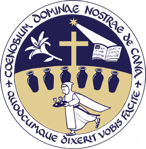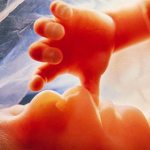Father Pius Mary Noonan’s homily
from Gaudete Sunday
Feast of Our Lady of Guadalupe

Joy, light and peace: such are the dominant themes of today’s Mass. And with reason, for the coming of the Lord is now imminent, and the Lord Himself is joy, light and peace. The fear we can feel at the perspective of the coming of the Lord of majesty now gives way in the liturgy to a joyful anticipation. The Lord is near, and the Lord is our Maker, our eternal Bridegroom, who is coming to restore all things. To those who are fainthearted, the prophet says to take courage, to not fear. To those in the dark, he says: be enlightened. To those who are disturbed, he announces unending peace. The traditional name for this Sunday, Gaudete, comes from St Paul’s words to the Philippians. They are not a suggestion or a simple an encouragement, but a command. We must rejoice, for such is the will of God who has revealed to us the very cause for our joy: He does not abandon us, but comes in person to steer our course to Himself. Those are not mere words – they are the simple facts offering to our meditation today.
This 12th day of December is also the feast of Our Lady of Guadalupe. The apparitions of Our Lady on the hill of Tepeyac have significance that goes far beyond the Mexican peoples and even beyond the entire American continent. Indeed, in many respects we can think that the apparition was meant also for our days. To understand why, it is sufficient to recall the context. In the year 1531, we are still in the first decades of the presence of the Church on the American continent. Columbus’ first voyage was hardly 40 years distant. Much had been accomplished, but the challenges were immense. While the conquistadors sometimes overplayed their hand and mistreated the native Aztecs, these people were their own worst enemy. The religion they practiced was one of the bloodiest imaginable. Human sacrifices were frequent, and on great feasts the number of sacrificed victims was in the thousands, their hearts being cut out alive and offered still beating to the awful bloodthirsty divinity.
It was into this terrifying world that Spain had not only brought the conquistadors; it had also brought missionaries and the True Faith. In those first decades, there were few conversions. But then Our Lady stepped in. It was to be the first major apparition of modern times. The message is brief and consists essentially of words of consolation addressed to the visionary, St Juan Diego, in the particular situation he found himself in, concerned for the health of his dying uncle, whom Our Lady cured. The heart of her message is summarised in these words spoken 490 years ago but which cannot fail to touch us to the depths still today:
Know and understand well, you my most humble son, that I am the ever-virgin Holy Mary, Mother of the True God for whom we live, of the Creator of all things, Lord of heaven and the earth. I wish that a temple be erected here quickly, so I may therein exhibit and give all my love, compassion, help, and protection, because I am your merciful mother, to you, and to all the inhabitants on this land and all the rest who love me, invoke and confide in me; I will listen there to their lamentations, and remedy all their miseries, afflictions and sorrows…. Hear me and understand well, my little son, that nothing should frighten or grieve you. Let not your heart be disturbed. Do not fear that sickness, nor any other sickness or anguish. Am I not here, who is your Mother? Are you not under my protection? Am I not your health? Are you not happily within my fold? What else do you wish? Do not grieve nor be disturbed by anything.
These words alone are enough to make Guadalupe memorable, but there was another aspect to these apparitions which would guarantee their lasting influence, namely the miraculous impression of the image of Our Lady on Juan Diego’s tilma, or apron. The image itself is a miracle, modern scientists telling us that it is nothing less than a photograph. With a powerful lens, one can even see in the eye of Our Lady the people who were present at the time. The tilma, made of course material, had a usual lifetime of about 30 years, and yet it is still here today almost five centuries later, having survived fire, bomb explosion and accidental spill of acid that should have completely destroyed it. More impressive still is the image itself. It depicts a woman “clothed with the sun, and the moon under her feet, and upon her head a crown of twelve stars.” The name she gave to the place in the native tongue of Juan Diego is “Coatlaxopeuh”— which the Spanish rendered as “Guadalupe” — meaning “the one who crushes the serpent”, here not just in reference to the Devil, but to a specific Aztecan deity, really only an image of Satan. On the tilma, Our Lady radiates peace and serenity with her consoling demeanour and posture, yet with a calm strength she overwhelms the violent and bloodthirsty gods of the Aztecs. She stands in front of the sun, for she is greater than their dreaded sun-god “Huitzilopochtli”. Her foot rests on the crescent moon, for she had clearly vanquished their foremost deity, the feather serpent “Quetzalcoatl.” Thanks to this miraculous image, it would not be long before the Aztecs would be converting en masse. Estimates reach up to nine million conversions over the next few years. As the Church was losing so many faithful in Europe to the Reformation, she was recovering them in America thanks to the apparitions of Guadalupe.
But there is another less well-known aspect about the image that is so very important for us today, namely, that Our Lady on the tilma is pregnant. We know this because of the cord she wears around the waist and that was typically worn by native pregnant women. It is this feature that makes her the principle patroness of the pro-life movement. The very image depicts for us the sacredness of life in the womb.
Nowadays, most people are rightly horrified by the human sacrifices performed by the Aztecs. Many do not realise that had it not been for Christianity, those sacrifices would likely still be in honour today, even though some historians think that, if the Spanish had not come, the Aztecs would have become extinct because of their bloody religion. Of greater concern today is the inability so many seem to have for acknowledging that other form of human sacrifice called abortion. Child sacrifice was, alas, a common practice among many ancient peoples, but it called down God’s curse on those who practiced it. Psalm 105 tells us that the Hebrews, in mingling among the pagan nations, learned their abominable ways: they sacrificed their sons, and their daughters to devils. And they shed innocent blood: the blood of their sons and of their daughters which they sacrificed to the idols of Chanaan. And the land was polluted with blood, and was defiled with their works. But then the Psalm goes on: the Lord was exceedingly angry with his people: and he abhorred his inheritance. And he delivered them into the hands of the nations: and they that hated them had dominion over them. And their enemies afflicted them: and they were humbled under their hands. Sadly, such awful rituals are not lost in a distant past. It doesn’t take much research to find out about the ritual abortions performed by satanists in our day.
Our Lady of Guadalupe is the patroness of the unborn, but we can also see in her a patroness of womanhood, of female dignity. Here we have another reason for the relevance of devotion to her. For decades now, there has been an unrelenting diabolical drive to deprive women of those two principle titles of glory that nature gives them, namely virginity and motherhood. Whereas in God’s plan, the virginity of a young woman makes her an image of the soul whom God wants to wed to Himself, and her glory lies in either dedicating her virginity to God in the religious life or in offering it to her husband in marriage, our world, under manifest diabolical influence, seems hellbent on brainwashing girls into thinking of virginity and motherhood as a stigma to be avoided at all costs. Our Lady of Guadalupe, the Virgin Mother, the sweet feminine image of God, is there to remind us of God’s beautiful plan and to encourage us to do what is in our power to promote an authentic restoration of a human and Christian culture, that respects the God-given complementarity of the sexes, that promotes chastity and honours and assists motherhood. If our world is to recover its senses, it is imperative that the truly feminine traits and genius be once again in honour.
That is why it is providential that this feast be given us was we are about to celebrate Christmas, for Christmas it is which safeguards the God-given dignity of our human family. If God Himself took flesh in the womb of a woman, if He wanted to be born into a family, to have the traits of infancy and childhood, to grow and reach human maturity, it is that all this is good. God becomes a babe, and makes Himself defenceless, so that we can learn to see God under the frail traits of infancy. What you did to one of these little ones, you did to me. If God wanted to be born of a young woman, it was so that every woman may be confident that she is dear to God, and that she is never closer to Him than when she guards her purity out of true love or when she brings new life into the world.
Our Lady of Guadalupe, intercede for our broken world. Give to our young people a great love and esteem for chastity. Take away the dark cloud that hangs over so many broken hearts and bodies and that puts out the youthful glow in their eyes. Bring back to our world the honour and joys of maternity and of large families. Help all of us to see the image of your Divine Son in every child and in every woman in need of support.
O Mary,
bright dawn of the new world,
Mother of the living,
to you do we entrust the cause of life
Look down, O Mother,
upon the vast numbers
of babies not allowed to be born,
of the poor whose lives are made difficult,
of men and women
who are victims of brutal violence,
of the elderly and the sick killed
by indifference or out of misguided mercy.Grant that all who believe in your Son
may proclaim the Gospel of life
with honesty and love
to the people of our time.Obtain for them the grace
to accept that Gospel
as a gift ever new,
the joy of celebrating it with gratitude
throughout their lives
and the courage to bear witness to it
resolutely, in order to build,
together with all people of good will,
the civilization of truth and love,
to the praise and glory of God,
the Creator and lover of life.(John Paul II, Encyclical Evangelium Vitae, no. 105)










